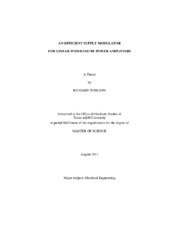| dc.contributor.advisor | Silva-Martinez, Jose | |
| dc.creator | Turkson, Richard | |
| dc.date.accessioned | 2011-10-21T22:03:45Z | |
| dc.date.accessioned | 2011-10-22T07:12:25Z | |
| dc.date.available | 2011-10-21T22:03:45Z | |
| dc.date.available | 2011-10-22T07:12:25Z | |
| dc.date.created | 2011-08 | |
| dc.date.issued | 2011-10-21 | |
| dc.date.submitted | August 2011 | |
| dc.identifier.uri | https://hdl.handle.net/1969.1/ETD-TAMU-2011-08-9805 | |
| dc.description.abstract | Radio Frequency (RF) Power Amplifiers are responsible for a considerable amount of the power consumption in the entire transmitter-receiver (transceiver) of modern communication systems. The stringent linearity requirements of multi-standard transceivers to minimize cross-talking effects makes Linear Power Amplifiers, particularly class A, the preferred choice in broadband transceivers. This linearity requirement coupled with the fact that the Power Amplifier operates at low transmit power during most of its operation makes the efficiency of the entire transceiver poor. The limited transceiver efficiency leads to a reduction in the battery life of battery operated portable devices like mobile phones; hence drastically limiting talk time. To alleviate this issue, several research groups propose solutions to improve PA power efficiency. However, these solutions usually have a low efficiency at low power and are mostly limited to narrow bandwidth applications.
In this thesis, the efficiency of a class A Power amplifier in wideband wireless standards like WiMax is improved by dynamically controlling the bias current and supply voltage of the PA. An efficient supply modulator based on a switching regulator architecture is proposed for controlling the supply voltage. The switching regulator is found to be slew-limited by the bulky inductor and capacitor used to regulate the supply voltage. The proposed solution alleviates the slew rate limitation by adding a bang-bang controlled current source. The proposed supply modulator has an average power efficiency of 81.6 percent and is suitable for wireless standards with bandwidths up to 20MHz compared to the relatively lower efficiencies and bandwidths of state of the art modulators. A class-A PA is shown to promise an average power efficiency of 21.3 percent when the bias current is controlled dynamically and the supply voltage is varied using the proposed supply modulator. This is a significant improvement over the poor average efficiency of 1.06 percent for a fixed bias conventional linear class A PA.
The project has been simulated using the TSMC 0.18 micrometer technology. | en |
| dc.format.mimetype | application/pdf | |
| dc.language.iso | en_US | |
| dc.subject | Power Amplifiers | en |
| dc.subject | Switching Regulator | en |
| dc.subject | Power Efficiency | en |
| dc.title | An Efficient Supply Modulator for Linear Wideband RF Power Amplifiers | en |
| dc.type | Thesis | en |
| thesis.degree.department | Electrical and Computer Engineering | en |
| thesis.degree.discipline | Electrical Engineering | en |
| thesis.degree.grantor | Texas A&M University | en |
| thesis.degree.name | Master of Science | en |
| thesis.degree.level | Masters | en |
| dc.contributor.committeeMember | Sanchez-Sinencio, Edgar | |
| dc.contributor.committeeMember | Datta, Aniruddha | |
| dc.contributor.committeeMember | Fink, Rainer | |
| dc.type.genre | thesis | en |
| dc.type.material | text | en |


